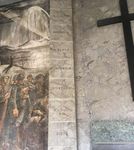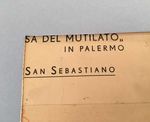From San Sebastiano to San Domino - Decolonizing ...
←
→
Page content transcription
If your browser does not render page correctly, please read the page content below
Dossier for Critical Preservation and Re-use of Casa del Mutilato II.Interventions.06
Decolonizing Architecture Advanced Course
Palermo, June 2018
06. From San Sebastiano
to San Domino
Rado Ištok
Missing Name of City in the Altar
Casa del Mutilato, Palermo, 2018II.Interventions.06 San Sebastiano San Sebastiano—i.e. Saint Sebastian—was the title of the competition project for Casa del Mutilato in Palermo by architect Giuseppe Spatrisano. Today, the name of the building carved above the peristyle is Tempio Munito Fortezza Mistica, omitting the reference to Saint Sebastian in the final project, yet surviving in the drawings preserved in the architect’s archive. What is the historical and contemporary significance of Saint Sebastian for Casa del Mutilato? Saint Sebastian (died c. 288 AD) was an early Christian saint and martyr killed during the Roman emperor Diocletian’s persecution of Christians. In Catholic church, St Sebastian is the patron saint of archers, soldiers, athletes, and of a holy Christian death. In the U.S.A., he is considered the patron saint of the Catholic War Veterans. Hence it is not difficult to understand Giuseppe Spatrisano’s choice of St Sebastian as a motto for the house of the war amputees and seriously disabled veterans. However, there is also another side to this saint. In art and literature, St Sebastian is traditionally depicted as a handsome young man pierced by arrows, although according to the legend he was rescued only to be later clubbed to death. Besides Christ, he is the only saint whose young and attractive body is fully exposed to us except of the parts covered by a loincloth. For this reason, the saint also became probably the first Western gay icon and a point of reference among gay artists at least since the 19th century. References to St Sebastian thus span from Il Sodoma and Guido Reni to Derek Jarman and Wolfgang Tillmans, as well as popular culture.1 As Richard A. Kaye explained, “Contemporary gay men have seen in Sebastian at once a stunning advertisement for homosexual desire (indeed, a homoerotic ideal), and a prototypical portrait of a tortured closet case.”2 Still, what is the relevance of the queer reading of Saint Sebastian in relation to Casa del Mutilato? If the building is a monument to men who fought in the WWI, the Spanish Civil War and the Italian colonial wars in East Africa, what was the story of men who didn’t fit in the model of a masculine soldier, namely gay men in the same period? According to Lorenzo Benadusi, professor of history at the University of Bergamo, gay men undermined the image that Benito Mussolini wanted to project on Italian manhood, seeing Fascism is a virile regime with Italians being strong and masculine, without the possibility of homosexuality existing in a Fascist regime. While no measures were taken on the national level, various local adherents to Fascist regime took the initiative to contribute to the eradication of the ‘degenerate’ men from the rest of the population. In 1938, some forty-five men believed to be homosexuals were arrested in the Sicilian city of Catania and consigned, together with men from other places in Italy, to internal exile on the island of San Domino in the archipelago of Tremiti in the Adriatic Sea, where they were housed in large dormitories with no electricity or running water. Yet the daily prison regime was relatively mild compared to other prison camps. While some gay men were also interned along with political prisoners on other small islands, such as Ustica and Lampedusa, San Domino was the only prison island where all the exiles were gay. This chapter 1 Arrows of desire: How did St Sebastian become an enduring, homo-erotic icon?, Independent, 10 February 2008, https://www.independent.co.uk/arts- entertainment/art/features/arrows-of-desire-how-did-st-sebastian-become-an-enduring-homo- erotic-icon-779388.html, accessed 19 May 2018. 2 Richard A. Kaye, Losing His Religion: Saint Sebastian as Contemporary Gay Martyr, in Outlooks: Lesbian and Gay Sexualities and Visual Cultures. Peter Horne and Reina Lewis, eds., New York: Routledge 1996, 86:105.
II.Interventions.06 of Italian history is also subject of the book La Città e l’isola. Omosessuali al confino nell’Italia fascista [The city and the island. Homosexuals in confinement in Fascist Italy, 2006], by Gianfranco Goretti and Tommaso Giartosio. In their book, the authors gathered testimonies by the local inhabitants of the island as well as rare accounts by former exiles. While some inmates felt shame over their exposure as gay, others enjoyed the paradoxical freedom of expression found on the island. As one of the former prisoners, identified only as Giuseppe B, recounted, being a gay man in one’s home town or village, one was under a constant risk of arrest. Once on the island, however, the prisoners could do theatre, dress as women, or celebrate various occasions including arrival of new prisoners, engage in romantic relationships and even fights over lovers. Although the atmosphere on the island was probably far from idyllic, according to Giuseppe B, when the internal exile regime on San Domino was ended due to the outbreak of WWII in 1939, some of the men wept as they were moved under house arrest in their home towns and villages. Others, such as prisoner identified only as Orazio L, a son of a Sicilian peasant arrested while in training to become a priest, pleaded to the judicial authorities for a chance to be allowed to leave the island in order to serve his Fatherland in the army, claiming that “To become a soldier, and then return to the seminary to live in retirement, is the only way in which I could repair the scandal and dishonour to my family.”3 Hence, islands such as San Domino were complex sites of oppression as well as relative freedom, homophobia and homoeroticism, reflecting in the tormented yet ecstatic face of Saint Sebastian in many paintings depicting the handsome martyr stricken by the arrows. The rise of the far-right across Europe, including Italy, is in many places met with resistance in anti-fascist demonstrations which confront the racism and homophobia of the far-right. Such demonstration have the potential of building alliances and solidarity among different minorities that feel imminently threatened by the far-right rhetoric propelling violence and hate crimes, such as the migrants and people of colour, on the one hand, and the LGBTQ+ community, on the other, as well as people belonging to both communities. The anti-fascist demonstration in Palermo in February 2018 thus included a section with the representatives of the Palermo Pride, leading to a programme proclamation of the team of Palermo Pride in March 2018 as “We, the anti-fascist and anti-racist garrison.”4 The military term of a garrison, a body of troops stationed in a particular location in order to guard it, brings us back to Casa del Mutilato. How can we reimagine Casa del Mutilato in Palermo as a base of the anti-fascist, anti-racist and anti-homophobic garrison? What martyrs can Casa del Mutilato honour today? One of the interventions at Casa del Mutilato which could commemorate the history of gay men, but also political prisoners, interned during Fascist times would be to place the names of the islands of San Domino, Ustica and Lampedusa on the pillars of the Sacrarium besides the existing inscriptions of locations of the Italian conquest rendered as Fascist violence in Europe and East Africa, thus honouring the men who deviated from the Fascist ideal of masculinity. 3 Alan Johnston, A gay island community created by Italy’s Fascists, BBC News, Italy, 13 June 2013, http://www.bbc.com/news/magazine-22856586, accessed 19 May 2018. 4 Palermo Pride, pronto il programma: “Noi, presidio antifascista e antirazzista”, http://www.palermotoday.it/cronaca/palermo-pride-30-giugno-2018-corteo-anticipazioni.html, accessed 19 May 2018.
II.Interventions.06
Images
Il Sodoma (Giovanni Antonio Bazzi) San Luca de Santis and Sara Colaone In Italia
Sebastiano, 1525. sono tutti maschi, Kappa Edizioni 2008.
Source: Galleria degli Uffizi, Florence. Source: Kappa Edizioni.
San DominoII.Interventions.06
Drawing of the competition proposal by Giuseppe Spatrisano.
Source:Giuseppe Spatrisano Archive at Fondazione
per l’Arte e la Cultura Lauro Chiazzese
Source:Giuseppe Spatrisano Archive at Fondazione
per l’Arte e la Cultura Lauro ChiazzeseII.Interventions.06
Cities in the Altar
Casa del Mutilato, Palermo, 2018
Bibliography
Luca De Santis, Sara Colaone, In Italia sono tutti maschi, 2008.
Gianfranco Goretti, Tommaso Giartosio, La città e l’isola. Omosessuali al confino nell'Italia
fascista, 2006.
Alan Johnston, A gay island community created by Italy’s Fascists, BBC News, Italy, 13 June
2013.
Arrows of desire: How did St Sebastian become an enduring, homo-erotic icon?, Independent,
10 February 2008.
Richard A. Kaye, Losing His Religion: Saint Sebastian as Contemporary Gay Martyr, in
Outlooks: Lesbian and Gay Sexualities and Visual Cultures. Peter Horne and Reina Lewis, eds.,
New York: Routledge 1996, 86:105.You can also read

























































